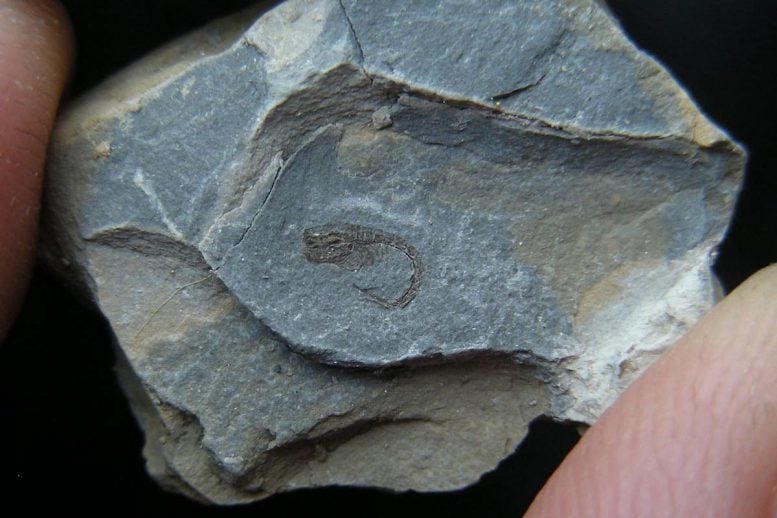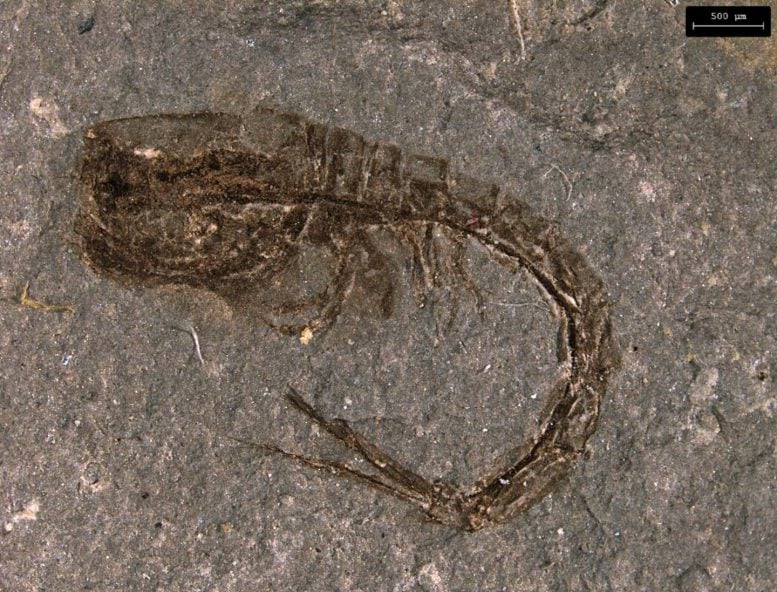
A small comma shrimp fossil held between fingertips demonstrates the fine details preserved in the fossils. Credit: Javier Luque
Tiny Fossils, Big Findings: Paleontologists Discover Odd Mid-Cretaceous Shrimp
Hundreds of tiny well-preserved fossils shed new light on one of the poorest fossil records of marine arthropods.
One of the most incomplete fossil records of marine life is being filled in by a new find by a team of paleontologists from the University of Alberta, Yale University, and the Smithsonian Tropical Research Institute—with the discovery of hundreds of tiny comma shrimp fossils.
“Comma shrimp are small, delicate crustaceans with one of the poorest fossil records among marine arthropods—which is shocking as they are abundant today and live in soft sediments with good fossilization potential,” said Javier Luque, lead author who conducted the research as a PhD candidate in the Department of Biological Sciences, and is now a postdoctoral associate at Yale University.
One of the most incomplete fossil records of marine life is being filled in by a new find by a team of paleontologists from the University of Alberta, Yale University, and the Smithsonian Tropical Research Institute — with the discovery of hundreds of tiny comma shrimp fossils.
The exceptional degree of preservation has even enabled paleontologists to create a 3D reconstruction of the comma shrimp, Eobodotria muisca.
Credit: Alex Duque & Masato Hattori
The excellent condition of the fossils allowed paleontologists to discern extremely fine details of the creatures, including eyes, antennae, mouthparts, and even fine hairs—and create a 3D reconstruction of what they might have looked like while alive.
“These fossils are of hundreds of adult males—which likely died suddenly in the water column while swarming during mating, falling slowly through the water with little or no damage,” said Sarah Gerken, co-author and professor at the University of Alaska Anchorage. “This left them in truly stunning condition.”
Marine fossils in the mountains
The scarcity of these fossils is in part due to where they lived—a shallow inner sea that, more than 90 million years ago, ran through what is now the uplifted Andes mountains.

Eobodotria bridges an approximately 165 million year gap in the cumacean fossil record, provides a reliable calibration point for phylogenetic studies and expands our understanding of exceptional preservation in past and present tropical settings. Credit: Javier Luque
“Exceptionally preserved fossils provide a crucial glimpse into the Earth’s past,” explained Luque. “Deposits like this are widely known from mid-to-high latitudes, but very few from modern tropical latitudes. This new fossil assemblage is the first of its kind in northern South America, and we hope it will become a reference for tropical paleontology in the region.”
The find follows on the heels of Luque’s discovery earlier this year of a “chimera” or “platypus crab,” incorporating the features of many different marine arthropods.
“Both of these species are the first of a trove of fossils we are still exploring to understand the species preserved here and the processes that allowed their fossilization,” said Luque. “It will give us a closer glimpse into the tropics’ past, and we hope our discoveries will open new avenues for the study of exceptional preservation in past and present tropical settings.”
The paper, “Exceptional preservation of comma shrimp from a mid-Cretaceous Lagerstätte of Colombia, and the origins of crown Cumacea,” was published in Proceedings of the Royal Society B. (doi: 10.1098/rspb.2019.1863)
2019-12-09 11:00:04Z
https://scitechdaily.com/paleontologists-discover-odd-shrimp-that-fills-hole-in-fossil-record/
CBMiXmh0dHBzOi8vc2NpdGVjaGRhaWx5LmNvbS9wYWxlb250b2xvZ2lzdHMtZGlzY292ZXItb2RkLXNocmltcC10aGF0LWZpbGxzLWhvbGUtaW4tZm9zc2lsLXJlY29yZC_SAWJodHRwczovL3NjaXRlY2hkYWlseS5jb20vcGFsZW9udG9sb2dpc3RzLWRpc2NvdmVyLW9kZC1zaHJpbXAtdGhhdC1maWxscy1ob2xlLWluLWZvc3NpbC1yZWNvcmQvYW1wLw
0 Comments:
Post a Comment